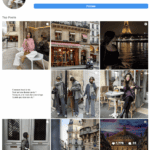Understanding Instagram Insights and Metrics
Instagram Insights is a robust tool that offers detailed analytics about your Instagram account’s performance, and understanding these insights is crucial for maximizing the return on investment (ROI) of your social media campaigns. With the right knowledge, businesses can use this data to make evidence-based decisions to enhance their marketing strategies.
Key Metrics in Instagram Insights
Instagram Insights provides numerous metrics that help evaluate account performance. These metrics can be categorized broadly into three sections: Activity, Content, and Audience.
Activity
This section provides data about how users interact with your account. Core metrics include:
- Profile Visits: The number of times your profile was viewed.
- Website Clicks: The number of clicks on the link in your profile bio.
- Call/Email Clicks: The number of clicks to call or email your business.
Content
Metrics in this section offer insight into the performance of your individual posts, stories, and IGTV videos. Key metrics include:
- Impressions: The total number of times all your posts have been seen.
- Reach: The unique number of accounts that have seen any of your posts.
- Engagement: The total number of likes, comments, saves, and shares.
- Views: Total views for videos or stories.
Audience
This section helps understand your followers better through various demographic and behavioral metrics:
- Follower Growth: Net increase or decrease in followers over a specified period.
- Top Locations: Cities or countries where your followers are based.
- Age Range: Age distribution of your followers.
- Gender: Gender distribution of your followers.
- Active Times: Days and hours your followers are most active.
Table of Important Metrics
| Metric | Description |
|---|---|
| Impressions | Total number of times posts are seen |
| Reach | Unique number of accounts viewing posts |
| Engagement Rate | Ratio of interaction (likes, comments) to reach |
| Follower Growth | Net change in the number of followers |
| Top Locations | Geographic locations of followers |
| Active Times | Time periods when followers are most active |
By systematically analyzing these metrics, businesses can glean valuable insights about their Instagram performance and user behavior. This information forms the foundation for making strategic decisions aimed at maximizing engagement and optimizing return on investment for social media campaigns.
Leveraging Demographic Data for Targeted Marketing
Instagram provides a comprehensive set of demographic data through its Insights feature, which is crucial for creating targeted marketing campaigns. Understanding and effectively leveraging this data can significantly enhance the precision and impact of your social media strategies.
The demographic data available includes age, gender, and geographic location. By analyzing this information, businesses can tailor their content and advertisements to meet the specific interests and preferences of their audience segments.
Firstly, examining the age distribution of your followers helps in identifying the primary age ranges. For instance, if the majority of your audience falls within the 18-24 age range, crafting content that appeals to younger demographics is advisable.
Secondly, gender data allows marketers to understand the male-to-female ratio among their followers. With gender-specific insights, businesses can personalize their messaging and visuals to better resonate with the dominant gender or create balanced content to attract both.
Additionally, geographic data reveals where your followers are located, down to the city level. Understanding the geographical distribution can be beneficial for local businesses or brands looking to expand in specific regions. Tailoring content to include local references or addressing location-specific needs can improve engagement rates.
Instagram Insights also showcases active times and days, which indicate when your audience is most active on the platform. Aligning your posting schedule with these peak times can increase visibility and interaction rates, ensuring that your content reaches the maximum number of followers.
By leveraging demographic data, businesses can also optimize ad targeting. Instagram Ads Manager allows for detailed audience targeting based on the demographic insights gleaned from Instagram Insights. This includes setting parameters for age, gender, and location to ensure that ads are displayed to the most relevant users.
Moreover, using these insights helps in segmenting the audience for different marketing objectives. For example, a brand may run distinct campaigns for older and younger demographics, each with tailored messaging and visuals, leading to higher engagement and conversion rates.
In conclusion, effectively utilizing demographic data from Instagram Insights can drive more strategic and targeted marketing efforts. By understanding the composition and behavior patterns of your audience, you can create personalized experiences that resonate more deeply, ultimately maximizing your return on investment.
Crafting Engaging Content Based on User Behavior Analysis
The analysis of user behavior on Instagram provides critical insights into crafting engaging content. By utilizing Instagram Insights, businesses can identify the type of content that resonates most with their audience, analyzing metrics such as likes, comments, shares, and save rates. These metrics not only reveal the overall engagement but also highlight specific user preferences.
Post Type Performance can be segmented into photos, videos, carousels, and stories. Understanding which format drives the highest engagement is pivotal for content strategy. For instance, it is widely documented that video content tends to generate more interactions than static images. According to a 2020 report by Mention, video posts receive 49% more interactions than image posts on Instagram.
Engagement Metrics provide quantifiable data on how users interact with posts. These metrics include:
- Likes: Indicate the immediate approval from the audience. Posts receiving a high number of likes should be analyzed for common features, such as visual appeal or caption style.
- Comments: Reflect a deeper level of engagement where users invest time to express their opinions. Content that sparks conversations tends to be more memorable and shareable.
- Saves: Suggest content is valuable enough for future reference. This metric helps identify evergreen content that continues to provide value over time.
- Shares: Amplify content reach by spreading it to users’ networks, crucial for organic growth.
Below is a sample table illustrating hypothetical average engagement rates for different post types based on industry data:
| Post Type | Average Engagement Rate |
|---|---|
| Photos | 1.22% |
| Videos | 1.51% |
| Carousels | 1.45% |
| Stories | 0.45% |
Another essential aspect of user behavior analysis is understanding peak activity times. According to a survey by Later, the best times to post on Instagram are generally during weekdays between 9 AM and 11 AM. However, the optimal posting time can vary drastically based on the target demographic and industry. Using Instagram Insights, businesses can ascertain the specific times when their audience is most active, allowing for strategic content scheduling.
Additionally, monitoring the performance of hashtags used in posts can provide insights into audience interests and trends. Effective hashtags can significantly enhance the discoverability of content. Tools like Instagram Insights and third-party analytics platforms can be used to track which hashtags are driving the most engagement and reach.
Conclusively, leveraging user behavior analysis through Instagram Insights facilitates the creation of content that aligns with audience preferences, fostering higher engagement and maximizing the return on investment (ROI) in social media campaigns.
Optimizing Ad Spend with Instagram Ads Manager

Instagram Ads Manager provides businesses with the tools necessary to effectively manage and optimize their ad spend. By leveraging Instagram Ads Manager, companies can ensure that their marketing budget is used efficiently to maximize return on investment (ROI). This chapter outlines the key features of Instagram Ads Manager and how they can be used to optimize ad spending.
One of the first steps in optimizing ad spend is setting a clear and realistic budget. Instagram Ads Manager allows advertisers to set daily or lifetime budgets. When setting your budget, consider your campaign objectives, target audience size, and overall marketing goals.
Ad Formats and Optimization
Instagram Ads Manager offers various ad formats, including photo ads, video ads, carousel ads, and stories ads. Each format serves different purposes and can be tailored to specific campaign objectives, such as brand awareness, engagement, traffic, or conversions. Selecting the right ad format based on your campaign goals is crucial. Instagram uses a comprehensive algorithm to optimize ad delivery by continuously monitoring performance and making necessary adjustments.
Targeting Options
Effective ad targeting ensures that ads are shown to the most relevant audiences. Instagram Ads Manager provides several targeting options, including:
- Demographic Targeting: Age, gender, and location.
- Interest Targeting: Based on user behavior and interests.
- Custom Audiences: Upload customer lists or target website visitors.
- Lookalike Audiences: Target users similar to your existing customers.
By combining these targeting options, advertisers can reach a more precise audience and reduce wasted ad spend.
Performance Tracking and Adjustment
Monitoring ad performance is essential to determine the effectiveness of your ad spend. Instagram Ads Manager provides various metrics, such as impressions, reach, clicks, and conversion rates, to evaluate ad performance. Regularly reviewing these metrics allows advertisers to make data-driven decisions and adjust their strategies accordingly.
| Metric | Description |
|---|---|
| Impressions | The number of times an ad is displayed. |
| Reach | The number of unique users who see the ad. |
| Clicks | The number of times users click on the ad. |
| Conversion Rate | The percentage of users who take a desired action (e.g., making a purchase) after clicking on the ad. |
A/B Testing
A/B testing, or split testing, involves creating multiple versions of an ad to determine which performs best. By running A/B tests, advertisers can identify the most effective ad elements, such as headlines, images, and calls-to-action. Instagram Ads Manager facilitates A/B testing by allowing easy creation and comparison of different ad variations.
Campaign Budget Optimization (CBO)
Campaign Budget Optimization (CBO) automatically distributes your budget across different ad sets based on their performance. This feature helps ensure that the best-performing ads receive more funding, maximizing overall campaign efficiency. Advertisers can enable CBO within Instagram Ads Manager to take advantage of automated budget allocation.
By understanding and utilizing the tools and features available in Instagram Ads Manager, advertisers can optimize their ad spend and achieve better results for their social media campaigns. Regular monitoring, data-driven adjustments, and strategic targeting are key to maximizing ROI through Instagram advertising.
Measuring ROI: Tools and Techniques for Success

Measuring the Return on Investment (ROI) of your Instagram campaigns is crucial for understanding the effectiveness of your social media strategies. Several tools and techniques can provide insights into how well your campaigns are performing and where adjustments may be needed.
1. Instagram Insights
Instagram Insights is an in-app analytics tool available for business accounts. It offers a variety of metrics that can be monitored in real-time, including post engagement, follower demographics, and overall reach. Utilizing these metrics helps in understanding audience behavior and how content resonates with them.
2. Key Performance Indicators (KPIs)
Define and track KPIs relevant to your objectives. Common KPIs on Instagram include:
- Engagement Rate: Measures the level of interaction (likes, comments, shares) on your posts relative to your follower count.
- Reach: Indicates how many unique accounts have seen your posts.
- Click-Through Rate (CTR): Important for understanding how many users are clicking on the links in your posts or ads.
- Conversion Rate: Tracks the percentage of users who take a desired action after engaging with your post or ad.
3. Instagram Ads Manager
Utilize the Instagram Ads Manager to gain deeper insights into your ad performance. This tool provides detailed reports on ad spend, ROI, and conversion rates. You can track how much you are spending on ads and compare it to the revenue generated, which is critical for optimizing your ad budget.
4. Google Analytics
Google Analytics can be integrated with Instagram to track traffic coming from your Instagram account to your website. Using UTM parameters in your links enables you to monitor which specific posts, stories, or ads are generating the most traffic and conversions. This helps in identifying high-performing content.
5. ROI Calculation
Calculating ROI involves comparing the revenue generated from Instagram campaigns to the costs incurred. This provides a clear picture of the profitability of your efforts. Here’s a basic formula:
ROI (%) = [(Revenue – Cost) / Cost] x 100
6. Tools for Enhanced Insights
Several third-party tools complement Instagram’s native analytics by offering more in-depth analysis and reporting capabilities. Tools such as Sprout Social, Hootsuite, and Socialbakers provide advanced metrics to help refine your strategy.
| Tool | Key Features |
|---|---|
| Sprout Social | Comprehensive social media management, in-depth reporting, and engagement tools. |
| Hootsuite | Scheduling, analytics, and monitoring across multiple social platforms. |
| Socialbakers | AI-driven insights, competitive analysis, and performance measurement. |
By effectively using these tools and techniques, businesses can measure their ROI with precision and make data-driven decisions to enhance their Instagram marketing strategies. Continually refining your approach based on insights gathered will lead to more successful social media campaigns.
Real-World Examples of Successful Instagram Campaigns
Instagram has been a powerful platform for brands looking to reach a wide and diverse audience. Examining real-world examples of successful Instagram campaigns provides valuable insights into effective strategies and techniques.
Nike’s Use of Inspirational Content
Nike has effectively used Instagram to inspire and engage its audience by sharing compelling stories of athletes and ordinary people achieving extraordinary feats. Their “Just Do It” campaign leveraged high-quality visuals and personal narratives to form an emotional connection with followers. According to Instagram data, posts that include storytelling elements see a 58% higher engagement rate than those that do not.
Audi’s Engaging Visual Content
Audi has seen success on Instagram through the use of striking visuals and professional photography. Their strategy focuses on showcasing the aesthetics of their vehicles in diverse settings, from urban landscapes to scenic routes. Audi’s account growth exemplifies the importance of visual appeal, as images with high-quality production values tend to receive 38% more engagement compared to regular images.
Glossier’s User-Generated Content
Glossier, a beauty brand, has capitalized on user-generated content (UGC) to create a sense of community and authenticity. They frequently feature posts from their customers, who use specific hashtags like #Glossier or #GlossierPink. This approach not only increases engagement but also boosts trust and credibility. Research shows that UGC is 42% more effective in establishing consumer trust than branded content alone.
Museum of Ice Cream’s Use of Instagram Stories
The Museum of Ice Cream has effectively used Instagram Stories to provide an immersive experience for its audience. By offering a behind-the-scenes look and exclusive content through Stories, they keep their followers engaged and drive more in-person visits. According to Instagram, stories generate a significant portion of total engagement, with businesses posting stories seeing a 21% increase in user interaction compared to regular posts.
Patagonia’s Advocacy and Activism
Patagonia has leveraged Instagram to communicate its commitment to environmental sustainability and social activism. By sharing stories and content related to their initiatives and campaigns, Patagonia has built a loyal following that values the brand’s principles and mission. Brands that engage in purpose-driven content see a 34% increase in consumer loyalty, according to industry data.
Conclusion
These examples illustrate that a successful Instagram campaign can hinge on diverse strategies, including inspirational content, high-quality visuals, user-generated content, immersive stories, and advocacy. By analyzing and emulating these effective practices, businesses can enhance their Instagram presence and maximize their return on investment (ROI).
Continuous Improvement: Adapting Strategies from Insights and Feedback

Continuous improvement is vital for the sustainable success of any social media campaign. By constantly refining strategies based on insights and feedback, businesses can ensure that their Instagram campaigns remain effective and relevant. This chapter outlines how to use data-driven approaches to adapt and enhance your strategies continuously.
Reviewing Performance Metrics
Regularly reviewing Instagram Insights is crucial for understanding what works and what doesn’t. Key metrics to focus on include:
- Engagement Rate: Measures the level of interaction (likes, comments, shares) relative to the number of followers.
- Impressions: Indicates how often your posts are viewed.
- Reach: Shows the number of unique users who have seen your posts.
- Follower Growth: Tracks the increase or decrease in followers over time.
Analyzing these metrics helps in identifying trends and patterns that can guide future content creation and targeting strategies.
Gathering and Implementing Feedback
User feedback, whether through direct comments, messages, or engagement metrics, provides invaluable insights into preferences and dislikes. To effectively gather and use this feedback:
- Encourage users to share their thoughts and opinions.
- Monitor comments and direct messages for recurring themes.
- Utilize Instagram Stories’ interactive features, such as polls and question stickers, to obtain direct input from followers.
Implementing feedback can lead to increased user satisfaction and higher engagement levels.
Adjusting Content Strategy
Based on the reviewed metrics and gathered feedback, adjust your content strategy accordingly. For example, if user engagement tends to be higher on certain types of posts (e.g., videos vs. images), consider focusing more on creating those popular content types. Regularly updating your content plan ensures it remains aligned with audience preferences and industry trends.
Optimizing Ad Strategies
Continual optimization of ad strategies is essential for maximizing returns on investment. This includes:
- A/B Testing: Conducting tests on different ad creatives, formats, and target audiences to determine what performs best.
- Budget Adjustment: Allocating more budget to high-performing ads and reducing spend on underperforming ones.
- Audience Refinement: Utilizing demographic and interest data to fine-tune target audiences for better relevance and engagement.
Metrics Comparison Table
The following table summarizes how different metrics can influence strategic adjustments:
| Metric | Potential Strategy Adjustment |
|---|---|
| Engagement Rate | Focus on high-engagement post types |
| Impressions | Improve post timing and frequency |
| Reach | Enhance hashtag and keyword usage |
| Follower Growth | Refine content to attract more followers |
In conclusion, continuously improving your Instagram strategies based on insights and feedback ensures your campaigns are effective and yield high returns on investment. By regularly reviewing metrics, gathering user feedback, and implementing necessary adjustments, you can maintain and enhance the performance of your Instagram campaigns.







